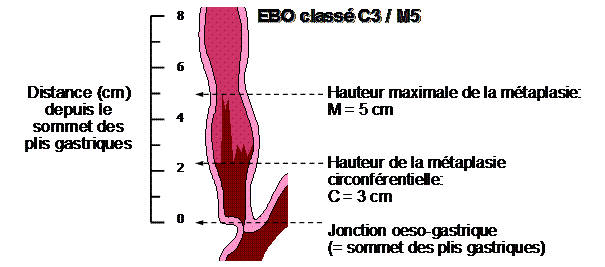Contents
Endobrachyoesophage
Endobrachyesophagus, or Barrett’s esophagus, is an anatomical abnormality affecting the lower esophagus in which cells in the lining are gradually transformed into intestinal cells. This transformation is called metaplasia. By far the most common cause is gastroesophageal reflux disease. If the diagnosis must be rapid in order to avoid the spread of metaplasia in the esophagus, the endobrachyesophagus will only degenerate into cancer in 0,33% of cases.
What is endobrachyesophagus?
Definition of endobrachyesophagus
Endobrachyesophagus (EBO), or Barrett’s esophagus, is an anatomical abnormality affecting the lower esophagus in which cells in the lining are gradually transformed into intestinal cells. This cellular change is called metaplasia.
Types d’endobrachyœsophages
There is only one type of endobrachyesophagus.
Causes of endobrachyesophagus
By far the most common cause is gastroesophageal reflux disease. When they are chronic, they can damage the esophageal lining and cause inflammation that leads to metaplasia.
But other causes are likely to be at the origin of endobrachyesophagus:
- Bile secretions;
- Enterogastric reflux.
Diagnosis of endobrachyesophagus
The diagnosis of Barrett’s esophagus involves two steps:
- A gastroscopy allowing to visualize using a flexible tube equipped with a camera the internal wall of the stomach, the esophagus and the duodenum. Barrett’s esophagus is suspected when tongue-shaped, red-colored mucosal extensions greater than 1 cm in size and resembling gastric mucosa are visible on the esophagus. This endoscopy also includes a measurement of the height of lesions suspected of metaplasia;
- A biopsy to confirm the presence of metaplasia.
A peptic ulcer (lesion on the lining) of the esophagus or esophageal stenosis (narrowing of the esophagus) are clinical symptoms that reinforce the diagnosis.
Recently, a team of American researchers has also developed a simple test that can be swallowed in order to allow the early detection of Barrett’s esophagus, which could constitute an alternative to endoscopy.
People affected by endobrachyesophagus
Endobrachyesophagus occurs frequently after the age of 50 and is about twice as common in men as in women. 10-15% of patients with gastroesophageal reflux disease will develop Barrett’s esophagus sooner or later.
Factors promoting endobrachyesophagus
Different factors can promote the occurrence of endobrachyesophagus:
- The age and extent of smoking;
- The male sex;
- Age over 50;
- A high body mass index (BMI);
- The increased presence of intra-abdominal fat;
- The presence of a hiatus hernia (passage of part of the stomach from the abdomen to the thorax through the hiatus opening of the diaphragm, an opening normally crossed by the esophagus).
Symptoms of endobrachyesophagus
Acid lifts
Endobrachyesophagus is often asymptomatic when it begins to develop. Its symptoms then merge with those of gastroesophageal reflux: acid reflux, heartburn.
Weight Loss
As it progresses, the endobrachyesophagus can cause swallowing difficulties, nausea, vomiting, loss of appetite, and weight loss.
bleeding
Sometimes the endobrachyesophagus can cause bleeding and cause anemia.
Black stool
Treatments for endobrachyesophagus
Treatments for Barrett’s esophagus are aimed primarily at reducing symptoms and limiting acid reflux in order to prevent the disease from spreading to a larger area of the esophageal lining. They combine the daily intake of antisecretory drugs – proton pump inhibitors and H-2 receptor inhibitors – and drugs that improve gastrointestinal motility (prokinetics).
It is very difficult to predict whether a patient with Barrett’s esophagus will develop esophageal cancer or not, so a follow-up gastroscopy is recommended at least every three to five years. Note that the annual incidence of carcinomatous degeneration of Barrett’s esophagus is 0,33%.
Prevent endobrachyesophagus
The prevention of endobrachyesophagus consists above all in avoiding or limiting gastroesophageal reflux:
- Limit foods and drinks known to promote reflux: chocolate, strong mint, raw onions, tomato, caffeine, theine, raw vegetables, dishes in sauce, citrus fruits, preparations rich in fat and alcohol;
- No smoking ;
- Eat a meal less than three hours before bedtime;
- Raise the headboard by twenty centimeters to avoid nocturnal acid reflux.










